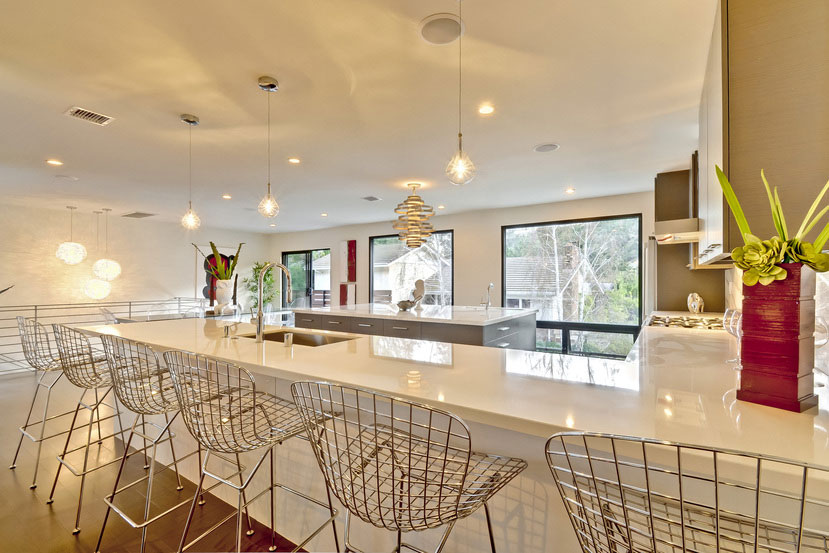
The kitchen is often considered the heart of the home. Imagine trying to chop vegetables, read a recipe, or entertain guests in a poorly lit kitchen. It can be frustrating and even dangerous.
Well-designed kitchen lighting ensures that every corner of the room is well-lit, making daily tasks easier and safer. Additionally, the right lighting can highlight architectural features, add warmth, and create a welcoming atmosphere.
A suitable kitchen lighting layout involves more than just installing a few light fixtures. It requires careful planning to ensure that different areas of the kitchen are illuminated correctly.
This comprehensive guide will help you understand the importance of good lighting in your kitchen and how to create a lighting layout that suits your needs.
A kitchen lighting layout is a strategic plan that outlines where different types of lighting fixtures will be placed in the kitchen. This plan considers various factors such as the size of the kitchen, the activities performed, and the desired ambiance.
A well-thought-out kitchen lights layout ensures that every part of the kitchen receives adequate illumination, enhancing both functionality and aesthetics.
A custom lighting layout is important because every kitchen is unique. The layout of your kitchen, the placement of appliances, and how you use the space will all influence the type of lighting you need.
A personalized lighting plan can address specific needs, such as brighter task lightingDefinition: Focused lighting used to illuminate specific work areas, such as under-cabinet lights in... for the cooking area and softer ambient lighting for dining. This tailored approach ensures that your kitchen is both practical and visually appealing.
Good kitchen lighting is crucial for several reasons:
To create a well-lit kitchen, it's essential to use a combination of different types of lighting. These include ambient, task, and accent lighting.
Ambient lighting provides general illumination for the kitchen. It's the base layer of lighting that ensures the entire room is well-lit. This type of lighting is typically achieved through ceiling fixtures, such as recessed lights or flush mounts. Ambient light sets the tone for the room and ensures that it is evenly lit.
Task lighting is focused lighting that illuminates specific areas where detailed tasks are performed. In the kitchen, this includes areas like countertops, the stove, and the sink.
Under-cabinet lights, pendant lights over an island, and directional recessed lights are common choices for task lighting. Task lighting helps reduce shadows and provides the bright light needed for precise activities.
Accent lighting is used to highlight specific features or areas in the kitchen. This type of lighting adds depth and dimension to the room. It can be used to showcase artwork, architectural details, or a beautiful backsplashDefinition: A protective wall covering behind a kitchen counter, often made of tile, glass, or metal... Read More. Accent lighting is often provided by track lights, wall-mounted fixtures, or small spotlights. It adds a layer of visual interest and enhances the overall design of the kitchen.
When selecting lighting for your kitchen, consider the following factors:
The primary purpose of kitchen lighting is to make the space functional. Think about the activities you perform in different areas of the kitchen. Ensure that each area has adequate lighting for its intended use. For example, you need bright, focused lighting for food preparation areas and softer, more diffused lighting for dining areas.
Lighting plays a significant role in setting the mood and style of your kitchen. Consider the overall design of your kitchen when choosing lighting fixtures. Whether your kitchen has a modern, rustic, or traditional style, select lighting that complements the décor. For inspiration, check out our traditional kitchen portfolio to see how lighting enhances various styles.
Additionally, think about the mood you want to create. Warm, soft lighting can make the kitchen feel cozy, while bright, cool lighting can make it feel more energetic and clean.
Energy efficiency is another important factor to consider. Choose LED lights whenever possible, as they consume less energy and have a longer lifespan compared to traditional incandescent bulbs. Energy-efficient LED bulbs not only reduce your electricity bills but also have a positive impact on the environment.
Determining the number of lights needed in your kitchen depends on the size of the room and the type of lighting used. A general rule of thumb is to provide about 70-100 lumens per square foot of kitchen space. This means that a 100-square-foot kitchen would need approximately 7,000-10,000 lumens in total.
Break down this total into the different types of lighting: ambient, task, and accent. For example, ambient lighting might account for 50-60% of the total lumens, task lighting 30-40%, and accent lighting 10-20%. This distribution ensures a balanced and effective lighting plan.
Proper placement of lights is crucial to achieving an effective kitchen lighting layout. Here are some key areas to focus on:
Creating a well-designed kitchen lighting layout involves careful planning and consideration of various factors. By combining different types of lighting and placing them strategically, you can enhance the functionality, safety, and aesthetics of your kitchen. For more design ideas, explore the best kitchen layouts to inspire your lighting choices.
Remember, good lighting can transform your kitchen into a welcoming and efficient hub of your home. For expert guidance and custom kitchen remodeling Los Angeles, consider consulting with professionals like Bradco Kitchen & Bath.
We can help you design and install the perfect lighting layout tailored to your kitchen’s unique needs. Contact us today at (323) 917-8668 to schedule a consultation!
BOOK AN APPOINTMENT